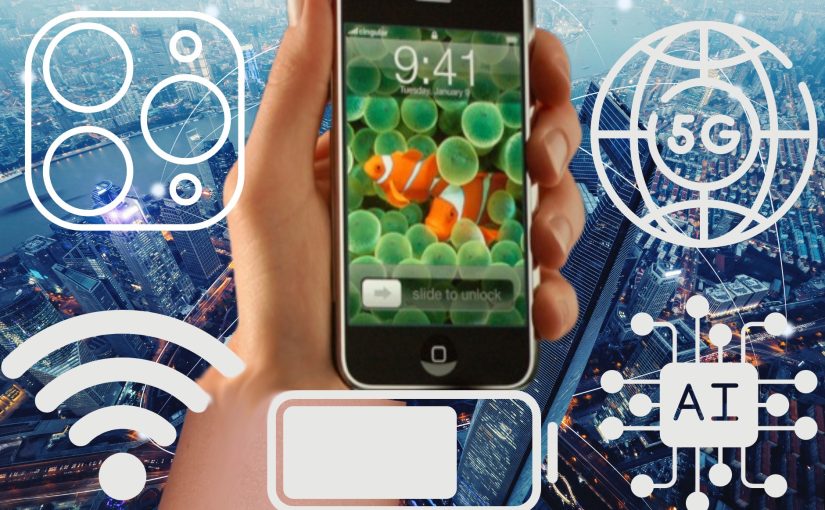Apple users have been eagerly awaiting the arrival of the new phone — the iPhone 16, with bated breath, despite the iPhone 15 having just been released in late 2023.
Rumors have already been swirling about a significant AI upgrade for the upcoming phone. Expected to debut in September 2024, the iPhone 16 is said to feature the A18 chip along with the next-generation M4 chip for Mac. This dual-chip configuration is anticipated to “significantly increase the number of built-in AI computing cores.”
The iPhone X vs the rumored iPhone 16 design pic.twitter.com/RtSi3cDt6T
— Apple Hub (@theapplehub) February 10, 2024
Here’s why the new iPhone 16 may be worth waiting for:
AI capabilities
Apple‘s iOS 18 is believed to be the biggest software update in iPhone history, with its Rich Communications Services (RCS) support receiving a significant update. It’s widely expected to come with several fresh AI features, including auto-generated Apple Music playlists, typing indicators, read recipes, audio messages, and higher-resolution images and videos.
This will reportedly include new Siri tools powered by large language models, which may remain exclusive to the iPhone 16. The microphone will see several improvements, such as better water resistance and a signal-to-noise ratio. Apple analyst Ming-Chi Kuo says that this will “improve the Siri experience significantly.”
“It could indicate that Apple expects to integrate more AI/AIGC capabilities into Siri as a key selling point of the iPhone 16,” he reiterated. However, Kuo also clarified that Apple will not fully adopt AI in the iPhone until the 2025 release of the iPhone 17 range. This decision is attributed to a 15% decrease in shipments of essential semiconductor components, suggesting that the current iteration of the phone may not be enough to reverse the company’s fortunes.
New battery
An early leak of what appears to be an iPhone 16 Pro battery prototype also shows that Apple may be working to improve battery life in its 2024 iPhone lineup. Hearsay stipulates that the new model will incorporate stacked battery technology, offering increased capacity and extended lifespan. While stacked batteries are prevalent in electric vehicles and medical devices, it’s only starting to emerge as a trend for phones.
Battery of early stage iPhone 16 Pro Proto
Features glossy metal shell, 3355mAh Capacity(13.02Wh), LCV 4.48V(Limited Charge Voltage)
Current stage prototype has changed some design: from glossy surface to frosted metal shell, and with a redesigned connector#Apple #appleinternal pic.twitter.com/QvguZ7CrtL— Kosutami (@KosutamiSan) November 20, 2023
Leaked images shared on X by the renowned Apple product leaker, @KosutamiSan, revealed a J-shaped lithium-ion battery bearing Apple’s branding and specifying a capacity of 3,355 mAh at 4.48V. Although the battery capacity of the iPhone 16 Pro falls short of the significantly larger 4,422 mAh battery of the iPhone 15 Pro Max, the upgrade suggests that Apple is attempting to optimize battery life within the physical limitations of the smaller Pro model’s design.
Users have often complained about battery issues with iPhones, hence it appears to be responding to consumer demand.
DO NOT 🚫 get the iphone 15. it LAGS. it’s the slowest phone i’ve ever had. it gets ridiculously hot and the flash doesn’t work half the time because of this. my battery life is already AWFUL like fully charged lasts around three hours at best. it is so bad. worst phone ever.
— char (@charnicle) February 15, 2024
@AppleSupport My iPhone 15 pro that’s only a couple weeks old with single digit charge cycles on it is dropping 10% charge from 80% to 70% overnight. The battery section shows that it’s the home and Lock Screen and Siri
But Siri is off and so are all the Lock Screen features. pic.twitter.com/CYkDg9o7Gs— Parth P Shah (@ParthShahTalks) February 14, 2024
Size of phone
The new phone will sport a slightly updated look, with the size of the iPhone 16 Pro increasing to 6.3 inches, while the iPhone 16 Pro Max will expand to 6.9 inches. This marks the first size upgrade in several years. However, the standard iPhone 16 will stay the same as its predecessor, along with the design.
Design of the iPhone 16
Conversely, the camera is changing its position from a square to a vertical alignment. Another Apple analyst, Majin Bu, recently leaked images featuring the same updated design. What we can see is that Apple’s latest camera design draws upon similar aesthetics of older iPhone models, like the iPhone X, which featured a pill-shaped camera and a slim bump design.
iPhone 16 new information (Rumor)
The size of the 16 Pro models, while many other sources are saying that the size has increased, I am seeing that the 16 Pro Max will have no change, at least that is what I am currently seeing. With no accurate measurements, I cannot guarantee,… pic.twitter.com/uUJjMVikK9
— Majin Bu (@MajinBuOfficial) February 4, 2024
The pill-shaped bump holds the separate Wide and Ultrawide lenses. Next to the lenses will be the microphone, with the camera flash positioned on the back of the device, outside the bump. The team at MacRumors also believes that we will be saying goodbye to the mute switch with an Action Button.
Better display
It has been hinted that the iPhone 16 will feature a significant display improvement, using OLED microlens array (MLA) technology to enhance brightness and power efficiency. This technology consists of a layer of microscopic lenses, also referred to as lenslets, placed on top of OLED pixels. It allows the phone to use less energy but maintain and increase its brightness.
New buttons
As mentioned, the Action button, which will replace the traditional mute switch, will enable users to perform a variety of tasks. These include activating the flashlight, turning on the camera, launching a shortcut, toggling a focus mode, using translate, switching Silent Mode on or off, and others.
The new Capture button apparently codenamed “Project Nova,” is reportedly able to respond to pressure and touch. In December, Bloomberg’s Mark Gurman reported that the button is dedicated to recording video. The Capture Button is set to be a capacitive button featuring haptic feedback instead of a mechanical one. It is expected to incorporate a force sensor capable of detecting pressure levels. It appears that it will replace the mmWave antenna in the U.S. and will be moved to the left side of the device, positioned below the volume and Action buttons.
A18 chip
While the iPhone 15 is already using an A17 chip, it is thought that the next version will be different to cut costs. A “chip expert” on the Chinese social media site Weibo was quoted by MacRumors as saying that the company plans to switch to the lower-cost N3E process for next year’s standard A17 chip, designed for the iPhone 16 and iPhone 16 Plus. This will be the first time Apple has designed a chip specifically for its standard iPhone models. Technology analyst Jeff Pu thinks all four iPhone 16 models will be equipped with A18-branded chips.
According to DigiTimes, Taiwan Semiconductor Manufacturing Company (TSMC,) which makes the 3nm A17 Pro chips for Apple, could begin installing equipment to produce 2nm chips later this year. The question is whether these chips will be available in sufficient quantities to be installed on the iPhone 17 or if we’ll have to wait for the iPhone 18 launch in late 2026.
Another aspect worth mentioning is the age-old issue of phones overheating, hence the iPhone 16 will endeavor to address this problem.
Apple is actively working on graphene thermal system of iPhone 16 Series to solve the heating problem existing before. And the battery of Pro series would change to metal shell, for the same reason.
— Kosutami (@KosutamiSan) November 16, 2023
Avid Apple user @KosutamiSan says that the company is actively working on a graphene thermal system for the iPhone 16 Series to solve the heating problem. For this reason, the battery of the Pro series would change to a metal shell. Graphene helps to deal with heat more efficiently.
Pu also thinks that the upcoming models are set to receive a memory upgrade, featuring 8GB of RAM. This marks an improvement from the 6GB of RAM found in the iPhone 15 and iPhone 15 Plus models.
5G and Wi-Fi
On that note, Pu continues his predictions, saying that Apple may offer the new Snapdragon X75 5G modem on the iPhone 16 Pro and 16 Pro Max models. Meanwhile, Kuo believes that the iPhone 16 will likely upgrade to Wi-Fi 7, which he says “will be more conducive to Apple’s integration of hardware products running on the same local network and provide a better ecosystem experience.”
Apple將積極升級硬體產品規格以建構更有競爭力的Vision Pro生態
1. Vision Pro的成功關鍵之一在於生態,當中包括能否與其他Apple硬體產品整合,而與此相關的主要硬體規格為Wi-Fi與UWB。
2. iPhone 15採用的UWB將規格升級,生產製程由16nm升級到更先進的7nm,有利近距離互動的效能提升或降低耗電。…
— 郭明錤 (Ming-Chi Kuo) (@mingchikuo) June 19, 2023
Universal port
Under new regulations, iPhone models must now come equipped with USB-C technology, as seen in this latest model. This is not expected to change.
Camera enhancements
Finally, an important feature of any phone is its photographing capabilities. Kuo states that Apple could update its smartphone photography with enhanced ultra-wide angle and telephoto cameras, featuring a notable shift to a 48-megapixel sensor.
Kuo notes that although the sensor will boast a higher megapixel count, it will produce 12-megapixel images via pixel binning, which will improve image quality over the iPhone 15 Pro models.
Genius is a key beneficiary of the re-accelerating cycle of high-end lens upgrades: iPhone 17 front camera upgrade, iPhone 16 Pro periscope and ultra-wide lenses, Vision Pro and Huawei P70 ultra-wide lenshttps://t.co/Qjkq8KJcIT
— 郭明錤 (Ming-Chi Kuo) (@mingchikuo) January 4, 2024
While the iPhone 16 series is set for an upgrade, the iPhone 17 lineup is anticipated to introduce an enhanced selfie camera, signaling a complete overhaul of the camera system.
When is the iPhone 16 coming out?
Barring any unforeseen setbacks, it’s safe to expect the release of the iPhone 16 and iPhone 16 Pro models in September. Of course there could be unexpected delays, however, our current prediction leans towards a September 2024 debut.
Featured image: Canva / Miquel C





















